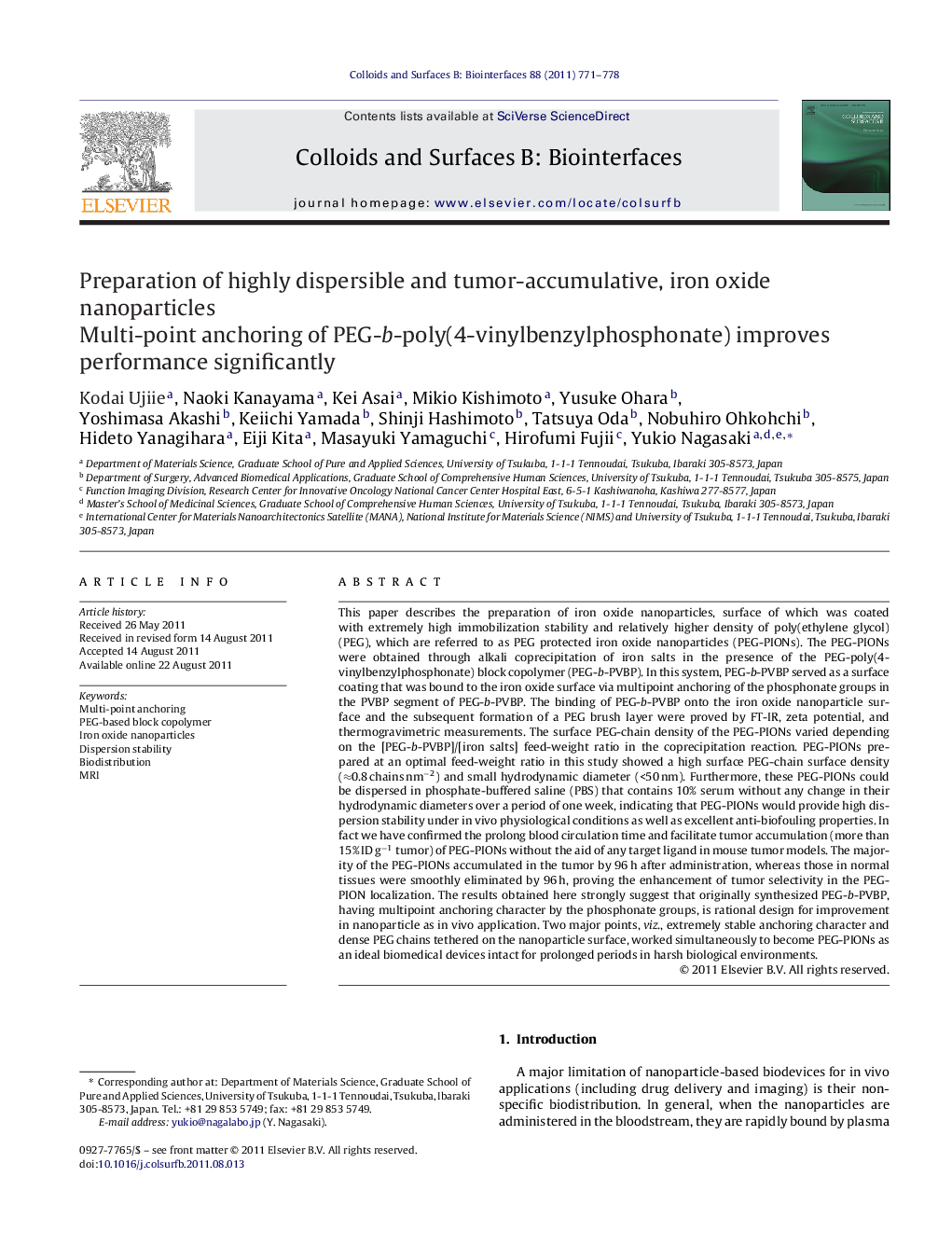| کد مقاله | کد نشریه | سال انتشار | مقاله انگلیسی | نسخه تمام متن |
|---|---|---|---|---|
| 601126 | 879931 | 2011 | 8 صفحه PDF | دانلود رایگان |

This paper describes the preparation of iron oxide nanoparticles, surface of which was coated with extremely high immobilization stability and relatively higher density of poly(ethylene glycol) (PEG), which are referred to as PEG protected iron oxide nanoparticles (PEG-PIONs). The PEG-PIONs were obtained through alkali coprecipitation of iron salts in the presence of the PEG-poly(4-vinylbenzylphosphonate) block copolymer (PEG-b-PVBP). In this system, PEG-b-PVBP served as a surface coating that was bound to the iron oxide surface via multipoint anchoring of the phosphonate groups in the PVBP segment of PEG-b-PVBP. The binding of PEG-b-PVBP onto the iron oxide nanoparticle surface and the subsequent formation of a PEG brush layer were proved by FT-IR, zeta potential, and thermogravimetric measurements. The surface PEG-chain density of the PEG-PIONs varied depending on the [PEG-b-PVBP]/[iron salts] feed-weight ratio in the coprecipitation reaction. PEG-PIONs prepared at an optimal feed-weight ratio in this study showed a high surface PEG-chain surface density (≈0.8 chains nm−2) and small hydrodynamic diameter (<50 nm). Furthermore, these PEG-PIONs could be dispersed in phosphate-buffered saline (PBS) that contains 10% serum without any change in their hydrodynamic diameters over a period of one week, indicating that PEG-PIONs would provide high dispersion stability under in vivo physiological conditions as well as excellent anti-biofouling properties. In fact we have confirmed the prolong blood circulation time and facilitate tumor accumulation (more than 15% ID g−1 tumor) of PEG-PIONs without the aid of any target ligand in mouse tumor models. The majority of the PEG-PIONs accumulated in the tumor by 96 h after administration, whereas those in normal tissues were smoothly eliminated by 96 h, proving the enhancement of tumor selectivity in the PEG-PION localization. The results obtained here strongly suggest that originally synthesized PEG-b-PVBP, having multipoint anchoring character by the phosphonate groups, is rational design for improvement in nanoparticle as in vivo application. Two major points, viz., extremely stable anchoring character and dense PEG chains tethered on the nanoparticle surface, worked simultaneously to become PEG-PIONs as an ideal biomedical devices intact for prolonged periods in harsh biological environments.
Figure optionsDownload as PowerPoint slideHighlights
► PEG-b-PVBP was newly synthesized for surface modification of ion oxide nanoparticles.
► Ion oxide nanoparticles were stably prepared by co-precipitation method in the presence of PEG-b-PVBP.
► In vivo accumulation of ion oxide nanoparticles in tumor attained more than 15% ID g−1.
► The excretion of ion oxide nanoparticles initially accumulated in liver was confirmed after 4d.
► The accumulation of ion oxide nanoparticles was clearly visualized by T2-weighted MRI.
Journal: Colloids and Surfaces B: Biointerfaces - Volume 88, Issue 2, 1 December 2011, Pages 771–778